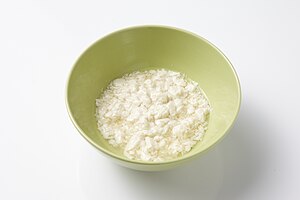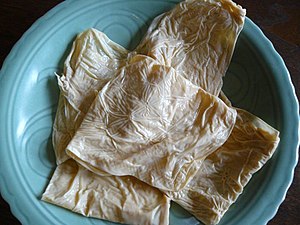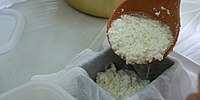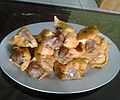Tofu/ja: Difference between revisions
No edit summary |
|||
| (14 intermediate revisions by the same user not shown) | |||
| Line 172: | Line 172: | ||
未圧搾豆腐は非常に柔らかいため、そのまま掬い取って提供されたり、凝固容器に入ったまま販売されたりする。 | 未圧搾豆腐は非常に柔らかいため、そのまま掬い取って提供されたり、凝固容器に入ったまま販売されたりする。 | ||
====特軟豆腐==== | ====特軟豆腐{{Anchor|Extra soft}}==== | ||
[[File:Sun-dubu.jpg|thumb|left|''スンドゥブ'' (特軟豆腐)]] | [[File:Sun-dubu.jpg|thumb|left|''スンドゥブ'' (特軟豆腐)]] | ||
| Line 237: | Line 237: | ||
====おから==== | ====おから==== | ||
{{Main|Okara (food)/ja}} | {{Main/ja|Okara (food)/ja}} | ||
おからは、[[:en:Japanese language|日本語]]の{{lang|ja|雪花菜(おから)}}に由来し、中国語では{{lang|zh|雪花菜}} ''xuěhuācài''(文字通り「雪の野菜」)、{{lang|zh|豆腐渣}} ''dòufuzhā''(文字通り「豆腐の沈殿物/残渣」)、韓国語では{{lang|ko|콩비지}} ''kongbiji''として知られている。 | おからは、[[:en:Japanese language|日本語]]の{{lang|ja|雪花菜(おから)}}に由来し、中国語では{{lang|zh|雪花菜}} ''xuěhuācài''(文字通り「雪の野菜」)、{{lang|zh|豆腐渣}} ''dòufuzhā''(文字通り「豆腐の沈殿物/残渣」)、韓国語では{{lang|ko|콩비지}} ''kongbiji''として知られている。 | ||
| Line 353: | Line 353: | ||
</gallery> | </gallery> | ||
===東南アジア=== | |||
=== | ====インドネシア==== | ||
==== | [[Indonesian cuisine/ja|インドネシア料理]]では、豆腐はタフと呼ばれ、[[:en:Hokkien|福建語]]の豆腐(tāu-hū, 豆腐)の発音に由来する借用語である。インドネシアの市場では、豆腐は通常2つの形態で入手できる。タフ・プティ(''tahu putih'')と呼ばれる一般的な白い木綿豆腐と、タフ・ゴレン(''tahu goreng'')と呼ばれる茶色い皮ができた揚げ豆腐である。タフ・ユン・イ(''tahu yun yi'')またはタフ・バンドン(''tahu Bandung'')は、[[turmeric/ja|ターメリック]]で着色された黄色い豆腐である。 | ||
東アジアおよび東南アジアの多くの地域で一般的な調理法は、豆腐を[[vegetable oil/ja|植物油]]、[[sunflower/ja|ひまわり油]]、または[[canola/ja|菜種油]]で揚げることである。インドネシアでは、通常[[palm oil|パーム油]]で揚げられる。揚げる前の豆腐は冷たい状態で販売されていることが多いが、そのまま食べることはほとんどなく、追加の調理が必要となる。 | |||
インドネシアの人気豆腐料理には、[[tahu gejrot/ja|タフ・ゲジュロット]]や[[kupat tahu/ja|クパット・タフ]]がある。タフ・ゲジュロットは、タフ・ポンと呼ばれる中空の揚げ豆腐を小さく切ったもので、[[palm sugar/ja|パームシュガー]]、酢、[[Kecap manis/ja|甘い醤油]]を混ぜて作った薄い水っぽいドレッシングをかけ、唐辛子、ニンニク、[[shallot/ja|エシャロット]]を添える。クパット・タフは、豆腐のスライスを[[ketupat/ja|クパット]](米ケーキ)とともに、通常ピーナッツソースのドレッシングで提供する。豆腐のスライスは、通常[[gado-gado/ja|ガドガド]]、[[ketoprak (dish)/ja|ケトプラク]]、[[siomay/ja|シオーマイ]]に混ぜられる。 | |||
バチェム(''Bacem'')は、[[:en:Central Java|中部ジャワ]]発祥の豆腐の調理法である。豆腐をココナッツウォーターで茹で、[[lengkuas/ja|ガランガル]]、インドネシアの月桂樹の葉、[[coriander/ja|コリアンダー]]、[[shallot/ja|エシャロット]]、[[garlic/ja|ニンニク]]、[[tamarind/ja|タマリンド]]、[[palm sugar/ja|パームシュガー]]と混ぜ合わせる。辛いココナッツウォーターが完全に蒸発した後、豆腐は黄金色になるまで揚げられる。その結果、しっとりしているがやや硬く、甘くてスパイシーな豆腐ができる。この調理された豆腐の種類は、[[:en:Indonesian language|インドネシア語]]で一般的にタフ・バチェム(''tahu bacem'')として知られている。タフ・バチェムは、[[tempeh/ja|テンペ]]や鶏肉と一緒に調理されるのが一般的である。 | |||
''Bacem'' | |||
<gallery> | <gallery> | ||
File:Tahu putih.JPG|''Tahu putih'' ( | File:Tahu putih.JPG|''Tahu putih'' (しっかりとした白い豆腐) | ||
File:Tahu digoreng.JPG|''[[Tahu goreng]]'' ( | File:Tahu digoreng.JPG|''[[Tahu goreng/ja|Tahu goreng]]'' (揚げ豆腐) は茶色い皮を持つ。 | ||
File:Tahu sumedang.jpg|''[[Tahu sumedang]]'' | File:Tahu sumedang.jpg|''[[Tahu sumedang/ja|Tahu sumedang]]''と唐辛子 | ||
File:Cirebon Tahu Gejrot.jpg|''[[Tahu gejrot]]'' | File:Cirebon Tahu Gejrot.jpg|''[[Tahu gejrot/ja|Tahu gejrot]]''と薄くて軽い辛味ソース | ||
File:Laksa Bogor 4.JPG| | File:Laksa Bogor 4.JPG|[[laksa/ja|ラクサ]]の上にのせられた黄色い豆腐(ターメリックで色付けされた豆腐) | ||
File:Bacem tahu.jpg|''Tahu bacem'' | File:Bacem tahu.jpg|''Tahu bacem''、パームシュガーとスパイスで煮込んだ豆腐 | ||
File:Kembang Tahu.jpg|''[[Douhua| | File:Kembang Tahu.jpg|''[[Douhua/ja|クンバンタフ]]''、甘い生姜シロップで提供 | ||
File:Frikadel Tahu.jpg|''Perkedel tahu'' | File:Frikadel Tahu.jpg|''Perkedel tahu'' goreng(豆腐とオランダの調理技術に基づくオランダ・インドネシア料理)[[Frikadeller/ja|フリカデラー]] | ||
File:Tahu Isi.jpg|''Tahu isi'' | File:Tahu Isi.jpg|''Tahu isi''、野菜、エビ、または鶏肉を詰めたインドネシアの揚げ豆腐で、唐辛子と甘いエビ[[Shrimp paste/ja|ペースト]]を添える | ||
File:Tahu Telor in Surabaya.JPG|''Tahu telor | File:Tahu Telor in Surabaya.JPG|''Tahu telor''または''Tahu tek''、卵焼き豆腐で、野菜、[[krupuk/ja|クルプク]]、ピーナッツソース、エビペースト、[[sweet soy sauce/ja|甘い醤油]]、[[sambal/ja|サンバル]]を添える | ||
File:Tahu Kupat.jpg|''Kupat tahu'' | File:Tahu Kupat.jpg|''Kupat tahu''、ライスケーキ、麺、甘い醤油を添えた豆腐 | ||
File:Tahu Campur.jpg|''Tahu campur'' | File:Tahu Campur.jpg|''Tahu campur''、牛肉と腱の入った豆腐スープで、スープ、[[Soy sauce/ja|醤油]]、[[shrimp paste/ja|エビペースト]]、野菜、[[krupuk/ja|クルプク]]、[[sambal/ja|サンバル]]を添える | ||
File:Batagor Savoy Homann Bandung.jpg|''Tahu bakso | File:Batagor Savoy Homann Bandung.jpg|''Tahu bakso''または[[batagor/ja|バタゴール]]、文字通りバクソ(ミートボール)、タフ(豆腐)、ゴレン(揚げた)。魚、タピオカ澱粉、または肉を詰めた揚げ豆腐。 | ||
File:Baksotahu1.jpg|''Tahu tuna | File:Baksotahu1.jpg|''Tahu tuna''。挽いたマグロを詰めた揚げ豆腐。[[:en:Pacitan Regency|パチタン]]、[[:en:East Java|東ジャワ]]の名物。 | ||
File:Tahu gimbal in Semarang.jpg|''Tahu gimbal | File:Tahu gimbal in Semarang.jpg|''Tahu gimbal''。[[:en:Semarang|スマラン]]発祥の、ピーナッツソースと''gimbal''(エビのフリッター)を添えた豆腐料理。 | ||
File:Tahu petis in Semarang.jpg|''Tahu petis | File:Tahu petis in Semarang.jpg|''Tahu petis''。''petis''(黒い[[shrimp paste/ja|エビペースト]]ソース)を詰めた揚げ豆腐。[[:en:Semarang|スマラン]]、[[:en:Central Java|中部ジャワ]]発祥。 | ||
File:Tahu aci.jpg|''Tahu aci | File:Tahu aci.jpg|''Tahu aci''。[[tapioca/ja|タピオカ]]澱粉を詰めた揚げ豆腐。[[:en:Tegal|テガル]]、[[:en:Central Java|中部ジャワ]]発祥。 | ||
File:Tau Kua Heci.jpg|''Tau kua heci | File:Tau Kua Heci.jpg|''Tau kua heci''。エビと豆腐の料理。[[:en:Binjai|ビンジャイ]]、[[:en:North Sumatra|北スマトラ]]発祥。 | ||
File:Tepo tahu.jpg|''Tepo tahu | File:Tepo tahu.jpg|''Tepo tahu''。揚げ豆腐に''tepo''(ライスケーキ)と野菜を添え、ピーナッツソースをかけたもの。[[:en:East Java|東ジャワ]]中央西部発祥。 | ||
File:TAHU BULAT.jpg|''Tahu bulat | File:TAHU BULAT.jpg|''Tahu bulat''。(丸い豆腐)。[[:en:Tasikmalaya|タシクマラヤ]]、[[:en:West Java|西ジャワ]]で創作された。 | ||
File:Tahu Walik.jpg|''Tahu walik | File:Tahu Walik.jpg|''Tahu walik''。[[:en:Banyuwangi|バニュワンギ]]、[[:en:East Java|東ジャワ]]の揚げ豆腐。 | ||
</gallery> | </gallery> | ||
====フィリピン==== | |||
= | [[:en:Philippines|フィリピン]]では、甘い菓子である[[taho/ja|タホ]]は、新鮮な豆腐に黒糖シロップと[[sago/ja|サゴ]]を加えて作られる。マレーシアとシンガポールのタホまたはドウファは「トウファファ」と呼ばれる。温かい軟らかい豆腐は(木製の桶から平らなスプーンですくい取って)スライス状にして、パンダン風味の砂糖シロップまたはパームシュガーシロップをかけて器で提供される。 | ||
<gallery> | <gallery> | ||
File:Taho2.jpg| | File:Taho2.jpg|タホが入ったカップ | ||
</gallery> | </gallery> | ||
====ベトナム==== | |||
= | ベトナムでは、豆腐は''đậu phụ''や''đậu hũ''と発音され、土製の壺に入れて持ち運ばれる軟らかい豆腐の一種である。 | ||
豆腐を使ったもう一つの人気料理は「ブン・ダウ・マムトム」で、[[rice noodles/ja|米麺]]に豆腐と[[shrimp paste/ja|エビペースト]]を添えたものである。 | |||
<gallery> | |||
File:Bún đậu mắm tôm (2019).jpg| | File:Bún đậu mắm tôm (2019).jpg|ブン・ダウ・マムトム | ||
File:Cooking class, Hoi An (32544686338).jpg| | File:Cooking class, Hoi An (32544686338).jpg|ダウ・フー | ||
File:Đậu hũ rán chay, tất niên nhà mệ 2018.jpg| | File:Đậu hũ rán chay, tất niên nhà mệ 2018.jpg|ダウ・フー・ラン(揚げダウ・フー) | ||
File:Bữa cơm gia đình ng6th4n2021 (tô đậu hũ sốt cà) (1).jpg| | File:Bữa cơm gia đình ng6th4n2021 (tô đậu hũ sốt cà) (1).jpg|ダウ・フー・ソット・カー(トマトソース添えダウ・フー) | ||
File:Món ăn cúng Tất Niên nhà mình, Tết Nhâm Dần 2022 (đậu hũ sốt cà) (3).jpg| | File:Món ăn cúng Tất Niên nhà mình, Tết Nhâm Dần 2022 (đậu hũ sốt cà) (3).jpg|タット・ニエン供物盆のダウ・フー | ||
</gallery> | </gallery> | ||
====ミャンマー==== | |||
==== | {{main/ja|Burmese tofu/ja}} | ||
{{main|Burmese tofu}} | |||
===その他の地域=== | |||
== | 一般的に、硬いタイプの豆腐は[[kebab/ja|ケバブ]]、モックミート、そして形が崩れにくい料理に用いられる。一方、柔らかいタイプの豆腐は、デザート、スープ、シェイク、ソースなどに使える。チョコレートと合わせてパイやムースを作るなど、豆腐を使ったデザートを楽しむ人もいる。これは、ビーガンやベジタリアンが牛乳や卵などの使用を避けるようになったことによる。 | ||
しっかりとした硬さの西洋風豆腐は、バーベキューグリルで形を保つため、バーベキューに使える。これらのタイプの豆腐は、マリネ液が豆腐全体に浸透しにくいため、通常は一晩マリネする(マリネ液の浸透を高める方法としては、フォークで何度も刺したり、マリネする前に冷凍・解凍したりする方法がある)。すりおろした硬い西洋風豆腐は、肉の代替品として[[textured vegetable protein/ja|テクスチャード植物性タンパク]](TVP)と組み合わせて使用されることもある。柔らかい豆腐は、乳製品不使用または低カロリーのフィラーとして使われることがある。絹ごし豆腐は、[[lasagna/ja|ラザニア]]など特定の料理でチーズの代わりに使用できる。豆腐は西洋の他の料理にも取り入れられており、例えばインド風カレーにも使われている。 | |||
豆腐や大豆タンパク質は、[[cheese/ja|チーズ]]、[[pudding/ja|プリン]]、[[egg (food)/ja|卵]]、[[bacon/ja|ベーコン]]などの製品の食感や風味に合うように工業的に加工できる。豆腐の食感は、[[freezing/ja|冷凍]]、[[purée/ja|ピューレ化]]、[[cooking/ja|調理]]によっても変化させられる。[[:en:the Americas|アメリカ大陸]]、[[:en:Europe|ヨーロッパ]]、[[:en:Australia|オーストラリア]]、[[:en:New Zealand|ニュージーランド]]では、豆腐は非動物性タンパク質の供給源であるため、[[vegetarianism/ja|ベジタリアニズム]]や[[veganism/ja|ビーガニズム]]と関連付けられることがよくある。 | |||
インドでは、豆腐は[[paneer/ja|パニール]]の低脂肪代替品として、同様の食感を提供するために使用されている。 | |||
== 栄養 == | |||
{{Nutritional value/ja | |||
{{Nutritional value | |name=豆腐(生・レギュラー) | ||
|name= | |||
|kJ=317 | |kJ=317 | ||
|water=85 g | |water=85 g | ||
| Line 466: | Line 440: | ||
| vitB6_mg=0.05 | | vitB6_mg=0.05 | ||
| folate_ug=15 | | folate_ug=15 | ||
| note=[https://fdc.nal.usda.gov/food-details/172476/nutrients | | note=[https://fdc.nal.usda.gov/food-details/172476/nutrients USDA FoodData Central Entryへのリンク]}} | ||
生の通常の豆腐は、85%が水分、8%が[[protein (nutrient)/ja|タンパク質]]、2%が[[carbohydrate/ja|炭水化物]]、5%が[[fat/ja|脂肪]]で構成されている(表)。基準量である100グラムあたり、豆腐は76[[calorie|カロリー]]を供給し、[[calcium in biology/ja|カルシウム]]、[[copper in biology/ja|銅]]、[[iron in biology/ja|鉄]]、[[manganese in biology/ja|マンガン]]の豊富な供給源([[Daily Value/ja|1日の摂取目安量]]の20%以上)となっている(表)。 | |||
==化学{{Anchor|Chemistry}}== | |||
== Chemistry == | 豆腐は、濁った[[colloid/ja|コロイド]]液体/溶液である豆乳から作られる。豆腐の構造は豆乳の成分、特にタンパク質粒子や油滴などのコロイド成分に関連している。タンパク質粒子の含有量は、大豆中のグロブリン比率の増加とともに増大する。様々な濃度の[[wikt:coagulant|凝固剤]]を添加することで、豆腐の種類が生まれる。 | ||
==タンパク質{{Anchor|Proteins}}== | |||
== Proteins == | 豆腐製造において重要な大豆の主要成分は、グリシニンを含む11S成分と、ヘマグルチニン、リポキシゲナーゼ、b-アミラーゼ、β-コングリシニンを含む7Sサブユニットである。大豆タンパク質の65~85%を占める2つの主要な大豆タンパク質成分には、グリシニンとβ-コングリシニンが含まれる。大豆タンパク質は多くの異なるサブユニットから構成されており、これらは熱、pH、イオン強度に敏感で、アミノ酸組成による親水性および疎水性相互作用のため、可溶性画分と粒子性画分に不均一に分布する。 | ||
==政治{{Anchor|Politics}}== | ==政治{{Anchor|Politics}}== | ||
Latest revision as of 20:38, 20 June 2025
| 豆腐 | |
|---|---|
 生の和風絹ごし豆腐のブロック | |
| 別名 | Bean curd |
| 主な材料 | 豆乳 |
豆腐(Tofu (Japanese: 豆腐, Hepburn: Tōfu, Korean: 두부; RR: dubu, Chinese: 豆腐; pinyin: dòufu))または豆乳凝固物とは、豆乳を凝固させ、得られたカードを様々な柔らかさの白い固形ブロック(絹ごし、ソフト、しっかり、特硬または超硬)に押し固めて作られる食品である。中国が発祥で、2,000年以上にわたり同国で食されてきた。豆腐は、多くの東アジア料理や東南アジア料理の伝統的な食材であり、現代の西洋料理ではしばしば肉の代替品として利用されている。
栄養学的に、豆腐はカロリーが低い一方で、比較的多量のタンパク質を含んでいる。鉄分の信頼できる豊富な供給源であり、製造に使用される凝固剤(例:塩化カルシウム、硫酸カルシウム、硫酸マグネシウム)によっては、高いカルシウムやマグネシウムの含有量を持つこともある。
タンパク質が豊富な食品源としての豆腐の栽培は、土地利用の必要性が最も低く(1000 kcalあたり1.3 m²)、温室効果ガス排出量も最も少ない部類に入る(タンパク質100 gあたり1.6 kgのCO₂)。
語源
英語の「tofu」は、日本語の「豆腐」(豆腐)に由来する。日本語の「tofu」は、中国語の「豆腐」(標準中国語:dòufǔ; tou4-fu)「豆乳凝固物、豆の発酵物」からの借用語である。
英語におけるこの言葉の最も古い文書記録は、1704年のドミンゴ・フェルナンデス・ナバレテの著書『航海と旅行の記録』の翻訳で、豆腐の製造方法が記述されている。また、「towfu」という言葉は、1770年にイギリスの商人ジェームズ・フリントからベンジャミン・フランクリンへの書簡にも登場する。「bean curd(s)」という豆腐を表す用語は、米国では少なくとも1840年から使用されている。
歴史
豆腐作りが最初に記録されたのは、中国の漢王朝時代の西暦965年である。中国の伝説では、その発明は安徽省の劉安王子(紀元前179年-122年)によるものとされている。豆腐とその製造技術は奈良時代(710年-794年)に日本に伝えられたが、明確な記録はなく、豆腐が記録に初めて登場したのは西暦965年である。一部の学者は、豆腐は10世紀から11世紀にかけてベトナムに伝わったと考えている。それは東南アジアの他の地域にも広まった。これはおそらく、仏教の広がりと同時期であり、豆腐が東アジア仏教の菜食主義において重要なタンパク源であったためと考えられる。明朝時代の李時珍は、『本草綱目』で豆腐の製造方法について記述している。以来、豆腐はベトナム、タイ、韓国を含む多くの国で主食となり、製造方法、食感、風味、用途において地域的な多様性が見られる。
起源に関する学説
豆腐の起源に関する3つの学説の中で最も一般的に信じられているのは、豆腐が漢王朝の王子である劉安(紀元前179年-122年)によって発見されたというものである。この説はもっともらしいが、この時代の信頼できる史料が少ないため、決定的な判断は難しい。中国の歴史では、重要な発明はしばしばその時代の重要な指導者や人物に帰属させられてきた。1960年、後漢時代の墓から発掘された石壁画は、豆腐の漢代起源説を裏付けるものとなった。しかし、一部の学者は、漢代の豆腐は未熟なもので、豆腐と見なされるほどの硬さや風味に欠けていたと主張している。
別の説では、豆腐の製造方法は、煮沸した大豆をすりつぶしたスラリーが不純な海塩と混ざり合った際に偶然発見されたとされている。そのような海塩には、おそらくカルシウム塩やマグネシウム塩が含まれており、それが大豆混合物を凝固させ、豆腐のようなゲルを生成した可能性がある。
豆腐の起源に関する最後の学説群は、古代中国人がモンゴル人の乳を凝固させる技術を模倣して豆乳を凝固させる方法を学んだとするものである。この説の主な証拠は、隋王朝時代(西暦581年~618年)にヨーグルトや軟質チーズのような一貫性を持つ料理に使われ、後にモンゴルの乳製品や製造方法の影響を受けた中国語の「乳腐」(乳腐、「凝固した乳」の意)という用語と、「豆腐」(豆腐、「凝固した豆」の意)または豆腐という用語との間の語源的な類似性である。これは興味深く、可能性のある説ではあるが、学術的な推測を超えてこの説を裏付ける証拠はない。
東アジア
中国
漢王朝(紀元前202年~紀元220年)の時代に豆腐の一種が発見された可能性があるが、中国で一般的な食品となるのは宋王朝(960年~1279年)まで待たなければならなかった。
中国では、豆腐は伝統的に故人の親族の墓で食べられていた。幽霊は顎をずっと昔に失っているため、豆腐だけが彼らが食べられるほど柔らかいと考えられていた。中国で冷蔵が普及する前は、豆腐は寒い季節に腐りにくいため、通常冬にのみ販売されていた。暖かい季節には、一度作られた豆腐は1日以上放置すると腐敗してしまった。
日本

豆腐は禅宗の僧侶によって日本にもたらされ、彼らは当初それを"Chinese curd" (唐符, tōfu)と呼んだ。豆腐に関する最古の日本の文献は、1183年に奈良の春日大社で供物として出されたことを記している。
中国から伝わった豆腐は、当初、沖縄の島豆腐、石川県白山市や富山県五箇山、徳島県祖谷地方の硬い豆腐など、硬い豆腐であったと考えられている。文禄・慶長の役後、土佐国(現在の高知県)には、捕虜となった秋月城主の朴氏によって硬い豆腐が伝わり、彼は町と寛大な保護を与えられ、その家族や部下は多くの硬い豆腐店を経営し、独占していた。徐々に、滑らかな食感の豆腐を生産する方法が考案され、現代の絹ごし豆腐が誕生した。江戸時代の1782年に出版された『豆腐百珍』には、豆腐の100の調理法が掲載されている。
東南アジア
東南アジアでは、豆腐は福建省出身の中国人移民によってこの地域に紹介された。これは、東南アジアの多くの国々が豆腐を、軟らかい豆腐または硬い豆腐を表す閩南語(それぞれ「tāu-hū」または「tāu-goan」)で呼んでいることからも明らかである。インドネシア、マレーシア、シンガポール、タイ、カンボジア、ミャンマー、フィリピン、ベトナムでは、豆腐は広く普及しており、多くの郷土料理に使われている。
インドネシアでは豆腐を「タフ」と呼び、インドネシア料理のタフ・スンバット、タウゲ・タフ、アシナン、シオーマイ、一部のカレーには、しばしば豆腐のスライスが加えられる。タフ・ゴレン、タフ・イシ、タフ・スメダンは人気の揚げ豆腐スナックである。
マレーシアとシンガポールでは、豆腐を「タウフー」と呼ぶ。マレーシアとシンガポールのインド系住民は、インドのミーゴレンやロジャック・パセンボルなどで豆腐を使用する。プラナカン料理では、ペナンカレーヌードルやラクサなど、しばしば豆腐を使用する。インドネシア、タイ、マレーシア、フィリピンは豆腐の主要生産国であり、多くの自治体に工場がある。
フィリピンでは、豆腐は朝食のスナック「タホ」(軟らかい豆腐、フィリピン・ホッケン語の豆腐「tāu-hū」に由来)として広く食べられている。また、「トクワ」(通常揚げられる、乾燥した硬い豆腐、フィリピン・ホッケン語の豆干「tāu-goan」に由来)としても食べられており、これは主食における肉の代替品として、また多くの地域料理における主食である。豆腐は10世紀から13世紀にかけて、宋王朝の中国人船員や商人によって、他の多くの食品とともにフィリピンの主要な食料品として群島にもたらされた。豆腐の使用と生産は、当初、セブやトンドなど、影響力のある中国系少数民族が住む都市部に限定されていたが、遠隔地の先住民の村や島々にも急速に広まった。
その他の地域
ベンジャミン・フランクリンは、1770年にジョン・バートラムへの手紙で初めて豆腐について言及したアメリカ人である。ロンドンへの旅行中に豆腐に出会ったフランクリンは、数粒の大豆を添え、それを中国の「チーズ」と呼んだ。1770年には、フランクリンはジェームズ・フリントと、中国人がカリバン(大豆)を豆腐に変換する方法について書簡を交わしている。フリントの手紙にある「Towfu」という表記は、英語における「tofu」の最も古い文献記録である。米国初の豆腐会社は1878年に設立された。1908年、農業と生物学のフランスの学位を持つ中国人アナキストでベジタリアンであった李石曽は、世界初の豆乳工場であり、フランスで初めて豆乳凝固物を製造販売する工場であるウージン・ド・ラ・カセオ=ソジャインを開設した。
しかし、豆腐は20世紀半ばまでほとんどの西洋人には知られていなかったが、ウィリアム・シャートレフとアキコ・アオヤギ(『The Book of Tofu』、1975年)によって米国で普及した。
生産
製品や製造規模に関わらず、豆腐の製造は基本的に以下の工程で構成されている:
- 豆乳の準備
- 豆乳を凝固させてドウファ(カード)を形成する
- 大豆カードを圧縮して豆腐の塊を形成する
乳製品のチーズの製造と同様に、乳を凝固させてカードを形成し、そのカードを圧搾して熟成させてチーズを形成する。典型的な豆腐の製造手順は、洗浄、浸漬、大豆を水で挽く、濾過、煮沸、凝固、圧搾である。
煮沸した豆乳中に懸濁しているタンパク質と油(乳化液)の凝固は、豆腐製造において最も重要な工程である。この工程は凝固剤の助けを借りて行われる。凝固は複雑な相互作用に依存しており、使用する大豆の品種とタンパク質含有量、スラリーの加熱温度、凝固温度など、多くの変数が関係する。
大豆タンパク質は主に7Sおよび11Sタンパク質から構成されている。これらのグロブリンの負の表面電荷は通常、互いに反発し合う原因となる。豆乳を加熱するとタンパク質が変性し、通常グロブリン構造の内側に向いている疎水性基が露出する。凝固剤からの陽イオンが負に帯電した基と結合する。タンパク質分子の正味電荷が中和されると、反発性の静電荷よりも魅力的な疎水性相互作用が優勢になり、タンパク質凝集体が形成される。
商業的には2種類の凝固剤(塩類と酸類)が使用されている。
塩凝固剤
- 硫酸カルシウム(石膏) (Chinese: 石膏; pinyin: shígāo) – 中国風の豆腐を作るための伝統的で最も広く使われている凝固剤で、柔らかいがややもろい食感の豆腐を生成する。凝固剤自体は無味である。石膏としても知られる硫酸カルシウムは地層から採掘され、化学処理や精製は不要なため、豆腐製造で使われる凝固剤の中で最も安価である。製造に使用すると、溶解度が低いために凝固反応が遅く、比較的水分含有量が多く、柔らかい食感の滑らかでゼラチン質の豆腐が形成される。この凝固剤を使用することで、カルシウムが豊富な豆腐も作られる。そのため、多くの豆腐メーカーはこの凝固剤を使用して、自社の豆腐を食事性カルシウムの優れた供給源として販売している。
- 塩化物型にがり塩または滷水 (Traditional: 鹵水, 滷水; Simplified: 卤水; Pinyin: lǔshuǐ) – 塩化マグネシウムと塩化カルシウム:これらの塩はどちらも水溶性が高く、同じように大豆タンパク質に作用するが、石膏は水溶性が非常に低く、豆腐形成の基礎となる大豆タンパク質沈殿においては異なる作用をする。これらは滑らかで柔らかい食感の豆腐を作るために使用される凝固剤である。日本では、主に塩化マグネシウムからなる「にがり」と呼ばれる白い粉末が、塩化ナトリウムを除去し水を蒸発させた後の海水から生産される。製造方法によっては、にがり/滷水には少量の硫酸マグネシウム(エプソム塩)、塩化カリウム、塩化カルシウム、および微量の他の天然塩も含まれる場合がある。「にがり」という言葉は日本語の「苦い」に由来するが、にがりも純粋な塩化マグネシウムも、完成した豆腐に知覚できる味を与えることはない。塩化カルシウムは海水中に有意な量では存在しないため、にがりとは見なされない。その風味と低コストのため、米国で広く使用されている。新鮮なきれいな海水自体も凝固剤として使用できる。
酸凝固剤
- グルコノデルタラクトン(GDL):チーズ製造にも使用される天然の有機酸で、ゼリーのような非常にきめ細やかな食感の豆腐を生成する。特に「絹ごし」やより柔らかい豆腐に使われ、完成品にかすかな酸味を与える。GDLはグルコースから誘導され、室温では白色粉末の形をとる。その分子構造には六員環の複素環が含まれており、水と接触すると加水分解され、GDLはゆっくりとグルコン酸に変化する。これにより、空気の隙間がなく、輸送中に壊れにくい単一の滑らかなゲルが形成される。GDLを凝固剤として使用すると、圧搾が不要なため、絹ごし豆腐を容器内で直接成形できる。この酸凝固剤は、絹ごし豆腐に滑らかで柔らかな食感を与えるために、硫酸カルシウムと一緒に使われることも多い。
- その他の食用酸:酢酸(酢)やクエン酸(レモン汁など)などの酸も、豆腐の味に影響を与え、密度や食感にばらつきはあるものの、豆乳を凝固させて豆腐を製造するために使用できる。
酵素凝固剤
- 豆腐の製造に用いられることが示されている酵素には、パパインや微生物由来のアルカリ性および中性プロテアーゼなどがある。さらに、パパインは、大豆タンパク質分離物や大豆グリシニン(11S)タンパク質から「インスタント豆腐」を製造するためのゲル化剤としても研究されてきた。
現代の豆腐メーカーは、最終製品の豆腐に望ましい食感を生み出す上でそれぞれが役割を果たすため、これらの凝固剤を1つまたは複数使用することを選択できる。異なる食感は、各凝固剤を使用して製造された豆腐の異なる孔径やその他の微細な特徴に起因する。凝固剤の混合液は水に溶かされ、その溶液は煮沸した豆乳に混ぜ込まれ、混合物が柔らかいゲルに凝固するまで攪拌される。
凝固剤は通常、1.5〜5.0g/kgの濃度で添加される。カルシウム塩またはマグネシウム塩からなるすべての凝固剤において、カルシウムまたはマグネシウムの正の二重結合イオンが、豆腐の一部となる大豆タンパク質の凝固を担い、それによってその栄養価を高めている。摂取される豆腐の1000分の1だけが凝固剤であり、凝固剤のほとんどは大豆タンパク質と反応してイオンに分解される。非反応性の部分は豆乳ホエイに溶解し、廃棄される。
カードは、製造される豆腐の種類に応じて異なる方法で処理される。絹ごし豆腐(嫩豆腐; 中国語でnèndòufu、日本語で絹漉し豆腐kinugoshi-dōfu)または豆腐プリン(豆花dòuhuāまたは豆腐花dòufuhuā、日本語でおぼろ豆腐Oboro-dōfu)の場合、豆乳は豆腐の最終包装内で直接凝固される。標準的な硬さの東アジアの豆腐の場合、豆乳カードは切り分けられ、ガーゼまたはモスリンを使って余分な液体がろ過され、軽くプレスされて柔らかい塊が作られる。東アジアの干し豆腐(中国語で豆干、日本語で凍み豆腐Shimi-dōfu)や西洋の豆腐のようなより硬い豆腐は、さらにプレスされてより多くの液体が除去される。ベトナムでは、カードはろ過されて四角い型に入れられ、最終製品はđậu khuôn(成形された豆)またはđậu phụ(中国語のdòufuをベトナム語で発音する方法の1つ)と呼ばれる。豆腐カードは冷やされて固められる。完成した豆腐は、切って味付けしたり、さらに加工したりすることができる。
デザート豆腐では酸味が好まれることがあるが、味付けに使われる酸は通常、主要な凝固剤ではない。凝固を誘発するのに十分な高濃度では、できた豆腐の風味や食感に悪影響を与えるためだ。豆腐の酸味や保存液のわずかな濁りは、通常、細菌の増殖、つまり腐敗の兆候でもある。
色
豆腐の白さは、最終的に大豆の品種、大豆タンパク質の組成、および豆腐ゲルネットワークの凝集度によって決まる。大豆の黄褐色は、アントシアニン、イソフラボン、ポリフェノール化合物などの色素化合物によるものであり、したがって、使用する大豆の品種が最終的な豆腐製品の色を決定する。黄色の色を減らす方法としては、豆腐製造に使用する豆乳溶液のpHを変化させてイソフラボン含有量を減らし、関連する化合物が沈殿しておからの抽出時に除去されるようにすることが挙げられる。豆腐ゲルの不透明性や、標準的な未調理の固形豆腐に典型的なオフホワイトの色は、豆腐のコロイド粒子による光の散乱に起因する。高レベルのカルシウム塩の添加や高タンパク質含有量は、より高密度で凝集したゲルネットワークの形成に寄与し、より多くの光を散乱させるため、より白い豆腐となる。
風味
豆腐の風味は一般的に「あっさり」と表現され、これは北米の消費者が求める味である。東アジアでは、より「豆の風味」が好まれる。豆の風味またはあっさりした味は、粉砕および調理工程で生成され、「熱間粉砕」または「冷間粉砕」のいずれかを使用して風味に影響を与えることができる。熱間粉砕法は、異臭を発生させることが知られている大豆タンパク質中のリポキシゲナーゼ酵素を不活性化することにより、豆の風味を低減する。これらの風味を排除することで、「あっさり」とした豆腐が作られる。冷間粉砕を使用した場合、リポキシゲナーゼが残り、豆のような香りを生み出すアルデヒド、アルコール、エステルなどの揮発性化合物が生成される。
種類
西洋と東洋の市場の両方で、多種多様な豆腐の種類と風味が販売されている。選択肢は多岐にわたるが、豆腐製品は大きく2つの主要なカテゴリーに分けられる。「生豆腐」(豆乳から直接製造されるもの)と「加工豆腐」(生豆腐から製造されるもの)である。豆腐の生産からは、様々な料理に使用される重要な副産物も生まれる。
未圧搾の生豆腐
未圧搾の生豆腐は、凝固した豆乳のカードを切ったり、水分を絞ったりしていないものである。豆乳をにがり(塩化マグネシウム)溶液で凝固させるか、石膏(硫酸カルシウム)の懸濁液で凝固させるかによって、異なる種類の未圧搾豆腐が生産される。石膏で凝固させたソフト豆腐は、滑らかでゼリーのような食感をしており、一般的にソフト豆腐、絹ごし豆腐、またはドウファ(豆花)として知られている。一方、にがりで凝固させたものは、非常に柔らかくスポンジ状の凝固した食感で、特軟豆腐またはスンドゥブ(순두부)として知られている。
未圧搾豆腐は非常に柔らかいため、そのまま掬い取って提供されたり、凝固容器に入ったまま販売されたりする。
特軟豆腐

未圧搾のにがり凝固ソフト豆腐は、韓国語で「スンドゥブ(순두부; 「マイルドな豆腐」)」と呼ばれる。豆乳に海水、または海塩で作った生理食塩水を混ぜて凝固させる。カードは緩く、柔らかいまま残る。作りたてのスンドゥブは、ほとんど味付けをせずに茹でて食べられる。市販のスンドゥブは通常、チューブで販売されている。また、スンドゥブチゲ(순두부찌개; 「ソフト豆腐の鍋」)の主な材料でもある。
スンドゥブの「スン」という言葉は漢字語に由来しないが、スンドゥブはしばしば中国語や日本語では漢字の「純」を使って翻訳される。「純」の韓国語の発音は「スン」であり、「純粋」という意味である。したがって、中国ではスンドゥブは「チュンドウフ(純豆腐; 「純粋な豆腐」)」と呼ばれ、日本では「ジュントウフ(純豆腐)」または「スンドゥブ(スンドゥブ)」と呼ばれる。
ソフト豆腐

ソフト豆腐は「絹ごし豆腐」とも呼ばれ、中国語ではnèndòufu(嫩豆腐; 「軟らかい豆腐」)またはhuádòufu(滑豆腐, 「滑らかな豆腐」)、日本語では絹ごし豆腐; 「絹で濾した豆腐」)、韓国語ではyeon-dubu(Korean: 연두부; Hanja: 軟豆腐; 「軟らかい豆腐」)と呼ばれる。石膏で凝固させたこの豆腐は、水切りや圧搾を行わないため、高い水分を含んでいる。絹ごし豆腐は、カードを切らずに豆乳を凝固させて作られる。絹ごし豆腐にはソフトやハードなどいくつかの硬さがあるが、すべての絹ごし豆腐は通常の木綿豆腐(圧搾豆腐)よりもデリケートで、料理における用途も異なる。絹ごし豆腐は、特にスムージーや焼き菓子において、乳製品や卵の代替品として使用できる。
ドウファ(豆花、または豆腐花dòufuhuā)、あるいは「豆腐脳」(豆腐腦または豆腐脑dòufunǎo)、あるいはダウファ(広東語)、タウファ(福建語)(豆花; 「豆の花」)は絹ごし豆腐に似ているが、通常は調理後数時間経ってから提供される。ほとんどの場合、温かいデザートとして食べられるが、塩漬けの漬物や辛いソースが加えられることもある。これは水分を多く含む柔らかい豆腐の一種である。箸では「ドウファ」をつかむのが難しいため、通常はスプーンで食べる。細かく刻んだネギ、乾燥エビ、醤油、チリソースなどの風味を加えれば、「ドウファ」は中国全土で人気の朝食料理となる。マレーシアでは、「ドウファ」は通常、温かい白または黒のパームシュガーシロップをかけて、またはリュウガンを添えて冷たくして提供される。朝食やデザートとして頻繁に提供される。通常、甘いショウガシロップ、または「ダールー」(打卤)と呼ばれるキノコ風味のグレイビーソースと共に提供される。通常、レストランで提供容器内で凝固される。「ドウファ」は常に豆腐の一種とは見なされず、それ自体が一種の食べ物と見なされることもある。
ソフト豆腐にはいくつかのバリエーションがある。黒ドウファ(黑豆花、hēidòuhuā)は黒大豆から作られた絹ごし豆腐の一種で、通常、硬い豆腐や干し豆腐ではなく、ドウファ(豆花)にされる。黒豆豆腐の食感は通常のドウファよりもわずかにゼラチン質で、色は灰色がかった色調である。この種の豆腐は、その素朴な「黒豆の味」のために食べられる。「枝豆豆腐」は、枝豆(新鮮な青大豆)から作られる日本の絹ごし豆腐の一種である。色は薄緑色で、しばしば丸ごとの枝豆が散りばめられている。
圧搾生豆腐
切って圧搾したカードから抽出される水分の量によって、木綿豆腐と特硬豆腐の2種類の豆腐が生産される。生豆腐は通常、水分含有量と鮮度を保ち、細菌の増殖を抑えるために、水に完全に浸した状態で販売される。
硬豆腐

木綿豆腐(中国語では老豆腐 lǎodòufu、日本語では 木綿豆腐、韓国語では모두부 mo-dubu)は、水切り・圧搾されているものの、高水分を保持した生豆腐の一種である。生肉のような硬さがあり、押すとすぐに弾力が戻る。内部の食感はしっかりとしたカスタードに似ている。この豆腐の表面には水切りに使われたガーゼの模様が残り、外側は内側よりもわずかにダメージに強い。箸で簡単に持ち上げられる。
日本の一部地域では、非常に硬い種類の木綿豆腐が食べられており、石川県の一部では「石豆腐」(いしどうふ)、富山県の五箇山や徳島県の祖谷では「岩豆腐」(いわどうふ)と呼ばれている。これらの硬い豆腐は、にがり(塩化マグネシウム)の代わりに海水を使用するか、濃縮された豆乳を使用して生産される。中には、余分な水分を除去するために重いおもりで圧搾されるものもある。これらの製品は、離島や山村、豪雪地帯など、交通の便が悪い地域で生産されている。
特硬豆腐

豆干(中国語で文字通り「乾いた豆腐」)は、液体の大部分が圧搾された特硬豆腐の一種である。豆干はすべての生豆腐の中で最も水分が少なく、完全に調理された肉のような硬さがあり、パニールに似たややゴム状の感触がある。薄くスライスしない限り、簡単に崩れない。一部の豆干の種類には、水切りと圧搾に使われたガーゼの模様がある。
豆干の調理法の一つとして、細く切ったものを豆干絲(豆干絲、中国語でdòugānsī、または単に干絲gānsī)と呼ぶ。この細切りは、ゆるく茹でた麺のように見え、冷製で、炒め物として、または日本の油揚げのようにスープに入れても食べられる。

百葉、千張、または干豆腐(百叶; 千张; 干豆腐)は、非常に薄い(厚さ約2mm)特硬豆腐の一種である。これは崩すことができない。表面には、圧搾に使われたガーゼによる四角い格子の隆起が全体に広がっている。2mm×2mmよりも細いひも状に切って、干絲と同様に食べることができる。また、次のような料理にも使われる。
- 素鶏(素鸡、「ベジタリアンチキン」):巻いたり、押し固めて揚げたりして作られる。
- 百葉結(百叶结 「百葉結び」):2cm×10cmにスライスして結んで作られる。
- 他の食材を百葉で包んだ様々な料理。
加工豆腐
多くの種類の加工豆腐が存在する。一部の加工技術は、冷蔵庫がない時代に豆腐を保存したり、賞味期限を延ばしたりする必要性から生まれたものと考えられる。その他の製造技術は、異なる食感や風味を持つ豆腐を作るために採用されている。
発酵豆腐

- 豆腐乳(中国語で豆腐乳、拼音: dòufurǔ、または腐乳 fŭrŭ、ベトナム語でchao)は、「腐乳」または「発酵豆腐」とも呼ばれ、干し豆腐を藁の下で完全に風乾させ、空気中の細菌の助けを借りてゆっくりと発酵させた立方体からなる。乾燥発酵豆腐は、塩水、中国の米酒、酢、刻んだ唐辛子、または米、豆味噌、大豆の混合物に浸される。紅腐乳(中国語で紅豆腐乳、拼音: hóng dòufurǔ)の場合、色付けのために紅麹米(Monascus purpureusで培養したもの)が加えられる。日本では、味噌漬けの豆腐を「豆腐の味噌漬け」と呼び、熊本の伝統的な保存食である。沖縄では、漬け発酵豆腐を「豆腐よう」(豆腐餻)と呼ぶ。これは島豆腐(沖縄特有の大きくて硬い豆腐)から作られる。麹菌、紅麹菌、泡盛で発酵・熟成させる。
- 臭豆腐(中国語で臭豆腐、拼音: chòudòufu)は、野菜と魚の塩水に漬けて発酵させた軟らかい豆腐である。豆腐の塊は刺激的なチーズのような匂いがし、時には腐敗した食べ物のような匂いがする。強い匂いにもかかわらず、臭豆腐の風味と食感は愛好家には高く評価されており、彼らはそれを「おいしい」と表現する。この豆腐の食感は、それが作られた軟らかい東アジアの豆腐に似ている。揚げたときに臭豆腐にできる皮は、特にカリカリしているのが最も良いと言われており、揚げた臭豆腐は通常、醤油、甘いソース、または辛いソースと一緒に提供される。
凍り豆腐


- 冷凍豆腐(中国語で凍豆腐 dòngdòufu、冰豆腐 bīngdòufu、どちらも「冷凍豆腐」の意) : 冷凍された豆腐。内部に発生する氷の結晶により、層状に見える大きな空洞が形成される。冷凍豆腐は、凍結過程で黄色がかった色になる。冷凍豆腐は中国の江南地方が発祥で、家庭で軟らかい豆腐から作られることが多い。香港、台湾、その他の江南からの移住者がいる地域では、名物として市販もされている。冬の料理として、ターツァイと組み合わせて定期的に食べられている。冷凍豆腐は提供前に解凍され、使用前に水分を取り除くために圧搾されることもある。 : 凍結中、氷の結晶が細胞壁に穴を開け、自由水と結合水の放出を促進し、凍結後に解凍した豆腐の総水分量を減少させる。初期のタンパク質-水結合は、より弾力性のあるタンパク質-タンパク質結合に不可逆的に置き換わり、ゲルネットワークの構造変化を引き起こし、硬さ、弾力性、凝集性、粘着性などの食感特性の増加につながる。
日本では、2種類のフリーズドライ豆腐が生産されている。これらは通常、食べる前に水に浸して再水和される。乾燥状態では、冷蔵を必要としない。
- 高野豆腐(kōya-dōfu、高野豆腐)は、凍り豆腐(凍り豆腐、文字通り「凍結豆腐」)としても知られるフリーズドライタイプである。もともとは、日本仏教の中心であり、精進料理、すなわち伝統的な仏教の菜食料理で有名な高野山に由来する。高野豆腐の製法は、冬の季節に豆腐を屋外に放置しておいたことから偶然発見されたと言われている。日本の市場では、フリーズドライされたブロックまたは立方体で販売されている。通常、出汁、酒またはみりん、そして醤油で煮込まれる。精進料理では、海藻から作られるベジタリアン昆布出汁が使用される。通常の方法で調理すると、スポンジのような食感で、ほんのり甘い、または風味豊かな味がする。味と風味は、どのような汁や煮汁で煮込まれたかによって異なる。より小さな断片の似たようなフリーズドライ豆腐は、インスタントスープ(味噌汁など)に含まれており、具材はフリーズドライされて密閉された袋に保存されている。
- 凍み豆腐(しき豆腐)は、主に東北地方で消費されている。高野豆腐が陰干しで作られるのに対し、凍み豆腐は天日干しで作られる。
副産物
湯葉

湯葉は、豆乳を浅い鍋で煮詰めた際に、液面に形成される主に大豆タンパク質と脂質からなる膜である。この膜を集めて乾燥させたものが、「豆乳の皮」として知られる黄色いシート状の食品で、中国語では腐皮 fǔpí、日本語では湯葉と呼ばれる。そのおおよその組成は、タンパク質50〜55%、脂質(脂肪)24〜26%、炭水化物12%、灰分3%、水分9%である。
この皮は、「腐竹」(中国語で腐竹 fǔzhú、ベトナム語でphù trúc、日本語でくさたけ)として知られる製品や、他の多くの形に乾燥させることもできる。湯葉は柔らかくもゴムのような食感を持つため、様々な形に折り畳んだり成形したりして、ヴィーガン料理で肉を模倣するためにさらに調理することができる。一部の工場では、湯葉やその他の大豆膜製品の生産に特化している。湯葉は一般的に乾燥した葉やシートの形で販売されている。また、「腐竹」を粥(朝食に食べる水っぽい米の混合物)に入れる人もいる。これにより粥がより滑らかになり、全く新しい食感が生まれる。また、粥が冷めると柔らかくてもろい皮が上にできる。湯葉は麺と一緒に調理される。
おから
おからは、日本語の雪花菜(おから)に由来し、中国語では雪花菜 xuěhuācài(文字通り「雪の野菜」)、豆腐渣 dòufuzhā(文字通り「豆腐の沈殿物/残渣」)、韓国語では콩비지 kongbijiとして知られている。
西洋では「豆粕」または「豆腐滓」として知られることもあるおからは、挽いて水に浸した大豆から豆乳を抽出した後に残る食物繊維、タンパク質、デンプンからなる豆腐の副産物である。ほとんどの豆腐生産文化圏では家畜飼料として利用されることが多いが、韓国料理のチゲの一種であるコンビジチゲ(콩비지찌개)など、日本料理や韓国料理でも他の用途がある。また、多くの西洋諸国ではベジタリアンバーガーの材料にもなっている。日本ではアイスクリームの製造にも使われている。
豆腐に似た食品
「豆腐」という用語は、大豆製品を使用しないが同様の食感を持つ凝固料理にも拡張して使用される。例えば、「アーモンド豆腐」(杏仁豆腐)、卵豆腐(卵)、胡麻豆腐(ごま)、またはピーナッツ豆腐(中国語落花生豆腐 luòhuāshēng dòufu、沖縄語ジーマーミ豆腐)などである。
その東アジアの起源と食感から、多くの食品が「豆腐」と呼ばれているが、その製造工程は厳密には類似していない。例えば、多くの甘いアーモンド豆腐は、実際には寒天やゼラチンで固められたゼラチン質のデザートである。ビルマ豆腐のような一部の食品は、豆類の「乳」から凝固されるのではなく、柔らかいポレンタ、韓国のムク、または雲南省(中国南西部)の鶏豆涼粉と同様の方法で固められる。
杏仁豆腐
「杏仁豆腐」(Chinese: 杏仁豆腐 xìngrén dòufu; 日本語: annindōfu)は、乳白色でゼラチン質の豆腐に似た食品であるが、大豆製品や豆乳は使わず、寒天で固められている。ココナッツミルクやマンゴージュースで作られた同様のデザートも、時には「ココナッツ豆腐」や「マンゴー豆腐」と呼ばれることがあるが、そのような名称は、大豆豆腐とココナッツまたはマンゴーをレシピに使った温かい料理にもつけられることがある。
ひよこ豆豆腐
ビルマ豆腐(ビルマ語でto hpu)は、ベサン粉(チャナダル粉)から作られた豆製品である。シャン族のものはイエロー スプリット ピー粉を使用する。どちらのタイプも黄色で、一般的にミャンマーと中国の雲南省でのみ見られるが、ビルマ族のものはビルマ料理を提供する一部の海外レストランでも入手可能である。この用語は中国語の豆粉(豆のゼリー)に由来すると考えられており、シャン族(雲南省のタイ族)を通じてビルマ料理に取り入れられた。ビルマ豆腐は、長方形または三角形に切ってフリッターとして揚げられることがある。
hsan to hpu(シャン地域ではhsan ta hpo)と呼ばれる種類は、米粉(hsan hmontまたはmont hmontと呼ばれる)から作られ、固まると黄色いビルマ豆腐と同じくらいの硬さで白色をしている。黄色い豆腐と同じようにサラダとして食べられる。
卵豆腐
卵豆腐(日本語: 玉子豆腐、卵豆腐、tamagodōfu)(Chinese: 蛋豆腐、dàndòufu; しばしばChinese: 日本豆腐、Rìběn dòufu、文字通り「日本豆腐」と呼ばれる)は、主な種類の風味豊かな豆腐である。出汁と合わせた全卵を型に流し込み、蒸し器で調理する(cf. 茶碗蒸し)。この豆腐は、卵の添加と、場合によっては食用色素によって、淡い金色をしている。この豆腐は、卵の脂肪とタンパク質が存在するため、絹ごし豆腐よりも濃密な食感と風味を持っている。普通の「干し豆腐」は、醤油で煮込んで(Chinese: 滷)醤油漬け豆腐にすることで味付けできる。屋台で売られている豆腐が、この醤油煮込みの形で提供されているのをよく見かける。今日、卵「日本」豆腐は、卵、水、植物性タンパク質、調味料で作られている。
卵豆腐は江戸時代に日本で発明された。1785年に書かれた書物『万宝料理秘密箱』には、卵豆腐の作り方が記録されている。その後、この日本の豆腐は東南アジアに伝わり、1995年にマレーシアから中国に紹介された。
卵豆腐100グラムあたり、カルシウム17mg、マグネシウム24mg、タンパク質5グラムが含まれているが、豆腐100グラムあたりには、カルシウム138mg、マグネシウム63mg、タンパク質12.2グラムが含まれている。豆腐と比較すると、卵豆腐の栄養価は低い。
日本で一般的な豆腐料理には、三鮮日本豆腐、エビ日本豆腐、ケチャップ日本豆腐、鉄板焼き日本豆腐、魚風味日本豆腐などがある。
ピーナッツ豆腐=
沖縄では、生のピーナッツを砕いて水を加え、濾して作られるピーナッツミルクに、澱粉(通常は地元でうむくじやうむかしとして知られるサツマイモ)を加えて加熱し、凝固させてジーマーミ豆腐(jīmāmi-dōfu)を作る。
中国語での同等品は落花生豆腐 luòhuāshēng dòufuである。
胡麻豆腐
胡麻豆腐(goma-dōfu)は、ゴマを滑らかなペースト状に挽き、液体と葛粉を混ぜて加熱し、凝固させて作られる。しばしば冷やして冷奴として供される。
千葉豆腐
千葉豆腐(simplified Chinese: 千叶豆腐; traditional Chinese: 千葉豆腐; pinyin: qiānyè dòufu; lit. 'thousand-layer tofu')は、豆乳の凝固によって作られる真の豆腐ではなく、大豆タンパク質分離物と澱粉源から作られた現代的な発明である。滑らかで弾力のある食感は、いくぶんかまぼこに匹敵する。もともと台湾の発明で、百葉豆腐と呼ばれていたが、既存の特硬豆腐である百葉との混同を避けるため、中国で改名された。
調理法
豆腐はそれ自体にほとんど味や匂いがない。そのため、豆腐は様々な料理に利用でき、他の食材の風味を引き立てる地味な背景として機能する。豆腐に風味を付けるために、しばしば醤油、唐辛子、ごま油などでマリネされる。
東アジア料理では、豆腐は生、煮込み、炒め物、スープ、ソースで調理、具材を詰めるなど、様々な方法で調理される。肉の代替品として豆腐を使用するという考えは、東アジアでは一般的ではない。
東アジア
中国
家常豆腐や麻婆豆腐(麻婆豆腐)など、多くの中国の豆腐料理には肉が含まれる場合がある。
中国料理では、ドウファ(豆花)は、茹でたピーナッツ、小豆、調理済みオートミール、タピオカ、緑豆、またはショウガやアーモンドで風味付けしたシロップなどのトッピングとともに提供される。夏の間、「ドウファ」は砕いた氷とともに冷たく提供され、冬には温かく提供される。 中国の多くの地域では、新鮮な豆腐は醤油とともに、またはさらに鰹節の削り節、ピータン(皮蛋 pídàn)、ごま油で風味付けして食べられる。
最も柔らかい豆腐を除いて、すべての種類の豆腐は揚げることができる。薄くて柔らかい種類の豆腐は、油で揚げられて、中が軽くふんわりするまで揚げられる。中国語では豆泡 dòupào、豆腐泡 dòufupào、油豆腐 yóudòufu、または豆卜 dòubǔと呼ばれ、文字通り「豆の泡」を意味し、揚げられた豆腐の形を泡として表現している。
使用する豆腐の種類によって、揚げ豆腐の食感は、外はカリカリで中はカスタード状のものから、プレーンなドーナツのように膨らむものまで様々である。前者は通常、中国料理ではニンニク醤油を添えてそのまま食べられるが、後者は魚のすり身を詰めてヨンタオフーにするか、スープで調理される。台湾では、揚げ豆腐が「阿給」と呼ばれる料理になり、揚げた油揚げの豆腐の中に麺を詰め、魚のすり身で蓋をしたものである。
木綿豆腐や豆干(中国の干し豆腐)のような水分含有量の少ない豆腐は、一口大の立方体または三角形に切られ、黄金色のカリカリした表面ができるまで揚げられる(中国語で炸豆腐 zhádòufu、文字通り「揚げ豆腐」)。これらは単独で、または軽いソースを添えて食べられるか、液体でさらに調理される。また、鍋料理に加えられたり、羅漢斎と呼ばれる精進料理の一部として含まれることもある。
四川料理の辛い調理法で、しっかりとした東アジアの豆腐を使うのは麻婆豆腐(麻婆豆腐)である。これは、牛肉、唐辛子、発酵豆ペーストのソースで豆腐を煮込んだものである。菜食主義版は麻辣豆腐(麻辣豆腐)として知られている。
干し豆腐は通常生では食べず、まず醤油と香辛料の混合液で煮込まれる。一部の干し豆腐は、特別な香辛料のブレンドで事前に味付けされており、その豆腐は「五香豆腐」(五香豆腐 wǔxiāng dòufu)または「滷水豆腐」(鹵水豆腐 lǔshuǐ dòufu)と呼ばれることがある。干し豆腐は通常、刻んだネギやスライスした肉を添えて薄切りにして提供される。
腐竹は、羊肉の煮込みやデザートスープによく使われる。湯葉は点心の皮としてよく使われる。フリーズドライ豆腐や冷凍豆腐は、水で戻して風味豊かなスープで楽しまれる。これらの製品は、少量の袋で何日もタンパク質を供給できるため、キャンプ旅行によく持参される。
豆腐乳は、その漬け液とともに少量、炒め物や煮込み野菜料理(特に葉物野菜、例: 空心菜)の風味付けに一般的に用いられる。調味料として、ご飯やおかゆと一緒にそのまま食べることも多い。
-
中国の軟らかい豆腐料理、ピータン豆腐
-
調理済みの干し豆腐の細切り(干絲、gānsī)
-
臭豆腐は非常に刺激的な匂いのする豆腐である。
-
中国雲南省元陽の屋台で焼かれた豆腐とジャガイモ
-
ドウファ(豆花)は、軟らかい豆腐料理である。新鮮な豆腐を温かくして甘いシロップをかけて供される。
-
四川風豆腐から作られた料理
日本

日本では、夏によく食べられる昼食に冷奴(冷奴)がある。これは、絹ごし豆腐またはしっかりした東アジアの豆腐に、おろしたての生姜、青ネギ、または鰹節をのせて醤油をかけて食べるものである。冬には、湯豆腐として頻繁に食べられる。これは、昆布出汁の土鍋で白菜や青ネギなどの野菜と一緒に煮込んだものである。
揚げ豆腐は、日本では厚揚げまたは生揚げ(生揚げ)と呼ばれる。薄い種類は油揚げと呼ばれ、いなり寿司によく使われる豆腐の袋状になる。
日本では、薄く衣を付けて揚げた豆腐に昆布出汁ベースのソースをかけたものを揚げ出し豆腐(揚げ出し豆腐)と呼ぶ。薄切りにして揚げた柔らかい豆腐は、日本では油揚げとして知られ、一般的に湯通しされ、醤油とみりんで味付けされ、きつねうどんなどの料理に供される。
岐阜県には、こも豆腐と呼ばれる郷土料理がある。これは、編み藁のこも(筵)で豆腐を包んだもので、表面にその模様が残る。包んだ豆腐はだし汁で煮込まれる。煮る過程で豆腐の中に空洞ができ、だし汁の味が染み込み、独特の多孔質の外観となる。
柔らかい豆腐は、調理する前に崩したり潰したりして、生の材料と混ぜ合わせることもできる。例えば、日本のがんもどきは、刻んだ野菜と潰した豆腐の混合物である。この混合物は澱粉でまとめられ、揚げられる。中国の家庭では、粗く潰した豆腐と豚ひき肉を同量ずつ混ぜて、蒸しミートローフやミートボールを作ることもある。
日本の味噌汁には、豆腐が頻繁に使われる。
-
醤油と飾り付けのニンジンを添えた日本風の絹ごし豆腐
-
厚揚げ、厚い揚げ豆腐
-
ゴマと葛粉で作られた胡麻豆腐
-
湯豆腐、または湯の中の豆腐
-
いなり寿司、様々な具材を詰めた油揚げ
-
味噌汁に入った豆腐
-
高山の市場で販売されている郷土料理のこも豆腐
韓国
豆腐は韓国料理において重要な役割を担っている。多くのスープにも用いられる。しっかりした硬さの豆腐は、醤油、ニンニクなどで味付けしてからフライパンで焼くことができる。同様の辛い味付けで煮込んだ豆腐料理は、ドゥブジョリム(조림)と呼ばれる。ドゥブキムチ(두부김치)は、湯通しした豆腐を長方形に切って皿の縁に並べ、炒めたキムチを中央に盛り付けたものです。これはお酒のつまみとして人気がある。 水切りをしていない柔らかいスンドゥブ(sun-dubu)は、スンドゥブチゲ(柔らかい豆腐の鍋)の主材料として使われるが、テンジャンクッ(味噌汁)、テンジャンチゲ(味噌鍋)、キムチチゲなどの他のスープや鍋物には、角切りにしたしっかりした豆腐が入っている傾向がある。他の多くの東アジア諸国と同様に、豆腐はドゥブチョンゴル(전골、豆腐鍋)と呼ばれる鍋料理でも楽しまれている。
-
味付け醤油を添えたパン焼き豆腐
-
ドゥブキムチ(湯通しした豆腐と炒めたキムチ)
-
トゥッペギに入った茹でたスンドゥブ(非常に柔らかい豆腐)
-
スンドゥブチゲ(辛い柔らかい豆腐の鍋)
-
醤油で味付けされた冷やし豆腐
-
崩した豆腐と潰したブロッコリーのサラダ
東南アジア
インドネシア
インドネシア料理では、豆腐はタフと呼ばれ、福建語の豆腐(tāu-hū, 豆腐)の発音に由来する借用語である。インドネシアの市場では、豆腐は通常2つの形態で入手できる。タフ・プティ(tahu putih)と呼ばれる一般的な白い木綿豆腐と、タフ・ゴレン(tahu goreng)と呼ばれる茶色い皮ができた揚げ豆腐である。タフ・ユン・イ(tahu yun yi)またはタフ・バンドン(tahu Bandung)は、ターメリックで着色された黄色い豆腐である。
東アジアおよび東南アジアの多くの地域で一般的な調理法は、豆腐を植物油、ひまわり油、または菜種油で揚げることである。インドネシアでは、通常パーム油で揚げられる。揚げる前の豆腐は冷たい状態で販売されていることが多いが、そのまま食べることはほとんどなく、追加の調理が必要となる。
インドネシアの人気豆腐料理には、タフ・ゲジュロットやクパット・タフがある。タフ・ゲジュロットは、タフ・ポンと呼ばれる中空の揚げ豆腐を小さく切ったもので、パームシュガー、酢、甘い醤油を混ぜて作った薄い水っぽいドレッシングをかけ、唐辛子、ニンニク、エシャロットを添える。クパット・タフは、豆腐のスライスをクパット(米ケーキ)とともに、通常ピーナッツソースのドレッシングで提供する。豆腐のスライスは、通常ガドガド、ケトプラク、シオーマイに混ぜられる。
バチェム(Bacem)は、中部ジャワ発祥の豆腐の調理法である。豆腐をココナッツウォーターで茹で、ガランガル、インドネシアの月桂樹の葉、コリアンダー、エシャロット、ニンニク、タマリンド、パームシュガーと混ぜ合わせる。辛いココナッツウォーターが完全に蒸発した後、豆腐は黄金色になるまで揚げられる。その結果、しっとりしているがやや硬く、甘くてスパイシーな豆腐ができる。この調理された豆腐の種類は、インドネシア語で一般的にタフ・バチェム(tahu bacem)として知られている。タフ・バチェムは、テンペや鶏肉と一緒に調理されるのが一般的である。
-
Tahu putih (しっかりとした白い豆腐)
-
Tahu goreng (揚げ豆腐) は茶色い皮を持つ。
-
Tahu sumedangと唐辛子
-
Tahu gejrotと薄くて軽い辛味ソース
-
ラクサの上にのせられた黄色い豆腐(ターメリックで色付けされた豆腐)
-
Tahu bacem、パームシュガーとスパイスで煮込んだ豆腐
-
クンバンタフ、甘い生姜シロップで提供
-
Perkedel tahu goreng(豆腐とオランダの調理技術に基づくオランダ・インドネシア料理)フリカデラー
-
Tahu isi、野菜、エビ、または鶏肉を詰めたインドネシアの揚げ豆腐で、唐辛子と甘いエビペーストを添える
-
Kupat tahu、ライスケーキ、麺、甘い醤油を添えた豆腐
-
Tahu baksoまたはバタゴール、文字通りバクソ(ミートボール)、タフ(豆腐)、ゴレン(揚げた)。魚、タピオカ澱粉、または肉を詰めた揚げ豆腐。
-
Tahu gimbal。スマラン発祥の、ピーナッツソースとgimbal(エビのフリッター)を添えた豆腐料理。
-
Tepo tahu。揚げ豆腐にtepo(ライスケーキ)と野菜を添え、ピーナッツソースをかけたもの。東ジャワ中央西部発祥。
フィリピン
フィリピンでは、甘い菓子であるタホは、新鮮な豆腐に黒糖シロップとサゴを加えて作られる。マレーシアとシンガポールのタホまたはドウファは「トウファファ」と呼ばれる。温かい軟らかい豆腐は(木製の桶から平らなスプーンですくい取って)スライス状にして、パンダン風味の砂糖シロップまたはパームシュガーシロップをかけて器で提供される。
-
タホが入ったカップ
ベトナム
ベトナムでは、豆腐はđậu phụやđậu hũと発音され、土製の壺に入れて持ち運ばれる軟らかい豆腐の一種である。
豆腐を使ったもう一つの人気料理は「ブン・ダウ・マムトム」で、米麺に豆腐とエビペーストを添えたものである。
-
ブン・ダウ・マムトム
-
ダウ・フー
-
ダウ・フー・ラン(揚げダウ・フー)
-
ダウ・フー・ソット・カー(トマトソース添えダウ・フー)
-
タット・ニエン供物盆のダウ・フー
ミャンマー
その他の地域
一般的に、硬いタイプの豆腐はケバブ、モックミート、そして形が崩れにくい料理に用いられる。一方、柔らかいタイプの豆腐は、デザート、スープ、シェイク、ソースなどに使える。チョコレートと合わせてパイやムースを作るなど、豆腐を使ったデザートを楽しむ人もいる。これは、ビーガンやベジタリアンが牛乳や卵などの使用を避けるようになったことによる。
しっかりとした硬さの西洋風豆腐は、バーベキューグリルで形を保つため、バーベキューに使える。これらのタイプの豆腐は、マリネ液が豆腐全体に浸透しにくいため、通常は一晩マリネする(マリネ液の浸透を高める方法としては、フォークで何度も刺したり、マリネする前に冷凍・解凍したりする方法がある)。すりおろした硬い西洋風豆腐は、肉の代替品としてテクスチャード植物性タンパク(TVP)と組み合わせて使用されることもある。柔らかい豆腐は、乳製品不使用または低カロリーのフィラーとして使われることがある。絹ごし豆腐は、ラザニアなど特定の料理でチーズの代わりに使用できる。豆腐は西洋の他の料理にも取り入れられており、例えばインド風カレーにも使われている。
豆腐や大豆タンパク質は、チーズ、プリン、卵、ベーコンなどの製品の食感や風味に合うように工業的に加工できる。豆腐の食感は、冷凍、ピューレ化、調理によっても変化させられる。アメリカ大陸、ヨーロッパ、オーストラリア、ニュージーランドでは、豆腐は非動物性タンパク質の供給源であるため、ベジタリアニズムやビーガニズムと関連付けられることがよくある。
インドでは、豆腐はパニールの低脂肪代替品として、同様の食感を提供するために使用されている。
栄養
| 100 g (3.5 oz)あたりの栄養価 | |||||||||||||||||||||||||||||||||||||||||||
|---|---|---|---|---|---|---|---|---|---|---|---|---|---|---|---|---|---|---|---|---|---|---|---|---|---|---|---|---|---|---|---|---|---|---|---|---|---|---|---|---|---|---|---|
| エネルギー | 317 kJ (76 kcal) | ||||||||||||||||||||||||||||||||||||||||||
1.9 g | |||||||||||||||||||||||||||||||||||||||||||
4.8 g | |||||||||||||||||||||||||||||||||||||||||||
8 g | |||||||||||||||||||||||||||||||||||||||||||
| |||||||||||||||||||||||||||||||||||||||||||
| その他の成分 | 量 | ||||||||||||||||||||||||||||||||||||||||||
| 水 | 85 g | ||||||||||||||||||||||||||||||||||||||||||
| †割合は、カリウムを除き、成人に対する米国 推奨値を使用して推定された。カリウムは、全米科学・工学・医学アカデミーの専門家による推奨に基づき推定された。 | |||||||||||||||||||||||||||||||||||||||||||
生の通常の豆腐は、85%が水分、8%がタンパク質、2%が炭水化物、5%が脂肪で構成されている(表)。基準量である100グラムあたり、豆腐は76カロリーを供給し、カルシウム、銅、鉄、マンガンの豊富な供給源(1日の摂取目安量の20%以上)となっている(表)。
化学
豆腐は、濁ったコロイド液体/溶液である豆乳から作られる。豆腐の構造は豆乳の成分、特にタンパク質粒子や油滴などのコロイド成分に関連している。タンパク質粒子の含有量は、大豆中のグロブリン比率の増加とともに増大する。様々な濃度の凝固剤を添加することで、豆腐の種類が生まれる。
タンパク質
豆腐製造において重要な大豆の主要成分は、グリシニンを含む11S成分と、ヘマグルチニン、リポキシゲナーゼ、b-アミラーゼ、β-コングリシニンを含む7Sサブユニットである。大豆タンパク質の65~85%を占める2つの主要な大豆タンパク質成分には、グリシニンとβ-コングリシニンが含まれる。大豆タンパク質は多くの異なるサブユニットから構成されており、これらは熱、pH、イオン強度に敏感で、アミノ酸組成による親水性および疎水性相互作用のため、可溶性画分と粒子性画分に不均一に分布する。
政治
豆腐は、政治家が対立候補を攻撃するために利用されてきた。2022年10月、[:en:[Suella Braverman|スエラ・ブレイバーマン]]は英国の下院で、「ガーディアンを読む、豆腐を食べるウォークラティ」を非難し、道路を妨害していると指摘した。2025年4月には、ドイツのキリスト教社会同盟党首マルクス・ゼーダーが、ドイツは「豆腐マニア」の代わりに、より多くのレバーケーゼ(一種のミートローフ)を楽しめるだろうと述べた。
関連項目
外部リンク
| この記事は、クリエイティブ・コモンズ・表示・継承ライセンス3.0のもとで公表されたウィキペディアの項目Tofu(18 June 2025, at 16:45編集記事参照)を翻訳して二次利用しています。 |





















































